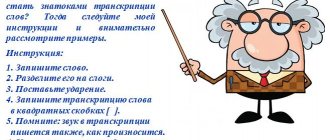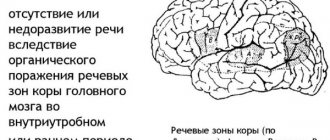Setting the sound Ш
Goal: to teach the child to pronounce the standardized sound sh .
Equipment: diagram of the structure of the articulatory apparatus when pronouncing the sound w ; probe, spatula; pictures-symbols, subject pictures.
Staging the sound w in various ways.
1. By imitation: - the child is offered a sample of sound pronunciation in combination with play images (the wind is noisy, a snake hisses, air comes out of a burst balloon, etc.); At the same time, visual control of correct articulation and tactile (tactile) sensations are used.
2. From the articulatory pattern: - the child is asked to reproduce the articulatory pattern of sound, apply the correct air stream, determine the presence/absence of a voice; the result should be a normalized sound.
3. From the reference sound: - the child is asked to open his mouth slightly, pronounce the sound t with aspiration at a slow pace 4-6 times, hitting the tubercles (alvioles) behind the upper teeth with the tip of the tongue; We gradually teach the child to smoothly lengthen the exhaled stream and not to hit the tubercles with the tip of the tongue, but only to raise the wide tip of the tongue towards them.
4. From the reference sound with mechanical assistance: - the child is asked to pronounce the sound for a long time with (the front teeth are always visible) with a spatula, carefully lift the wide tongue behind the upper teeth and slightly move it back - to the alveoli (the edges of the spatula are approximately at the level of the fourth incisors ); then they achieve this skill from a speech pathologist without mechanical assistance; - we invite the child to open his mouth slightly, for a long time, without a voice, the child pronounces the sound r and with the tip of a spatula brought to the hyoid frenulum, the speech therapist stops the vibration of the front part of the tongue - we hear a hissing; after several repetitions, you can cause a hiss by barely bringing the spatula to the hyoid frenulum; then remove it and, bringing the teeth closer together, achieve the correct sound of sh.
Setting the sound C (it is basic in the group of whistling sounds)
1. From the correct silent pattern C formed with the help of articulatory gymnastics: lips in a smile, a small gap between the teeth, the tip of the tongue behind the lower teeth... we suggest blowing on the lower lip with this pattern, we control the articulation in the mirror, we also control the cold air with the back of the hand jet.
2. By auditory and visual imitation of the correct articulation and sound of the sound C in an adult (this option can be tried if the sound was completely absent in speech).
3. Mechanically using a probe (see illustration) or using other available means that replace the probe. The main thing is that the available means are not dangerous and cannot injure the child’s articulation organs. Typically, a probe is used to create a groove in the middle of the tongue. It is better if a speech therapist does this.
4. Production from other correctly pronounced sounds.
- from the sound F: when pronouncing F, press the lower lip to the incisors and move it slightly down;
- echo I: whisper the sound I and, without changing articulation, blow on the tip of the tongue;
- from the sound Ш: when pronouncing Ш, lower the tip of your tongue behind your lower teeth;
- from the sound T: blow on the tongue, pronouncing T, so that the breeze flows along the back of the tongue, and a cold air stream is felt on the palm.
You can invite the child to “step” with the tip of his tongue on the adult’s finger (finger under the chin). This helps to keep the tongue down.
There are some features of the production and automation of whistling in lateral sigmatism. The tongue is in the “humpbacked bridge” position, the tip of the tongue is at the lower gum, the lips are in a smile. The child exhales onto the tongue, and it is important to ensure that the cheeks do not swell. A sound resembling S should appear. In the future, we gradually reduce the exaggerated protrusion of the tongue, bringing the upper and lower teeth closer together. Automation with lateral sigmatism should start from a combination with the sound T (sta, ste...), then in a reverse syllable (as, ys...), and finally in straight syllables (SA, se...).
When pronouncing C hissingly, when the tongue is moved deeper into the oral cavity, exercises are used to form a wide, spread-out tongue, and first an interdental C is placed, which is then transferred behind the teeth.
Setting the sound
Goal: to teach the child to pronounce the standardized sound zh .
Equipment: diagram of the structure of the articulatory apparatus when pronouncing the sound w; probe, spatula; pictures-symbols, subject pictures.
Sound production in various ways.
1. By imitation: - the child is offered a sample of sound pronunciation in combination with play images (the buzzing of a beetle, a bee, a bumblebee, the rotation of a spinning top, etc.); At the same time, visual control of correct articulation and tactile (tactile) sensations are used.
2. From the articulatory pattern: - the child is asked to reproduce the articulatory pattern of sound, apply the correct air stream, determine the presence/absence of a voice; the result should be a normalized sound.
3. From the reference sound: - the main method: the child is asked to pronounce the sound w and, adding a voice, get the sound w; - the child is asked to open his mouth, pronounce the sound d with aspiration at a slow pace 4-6 times, hitting the tubercles (alveoli) behind the upper teeth with the tip of his tongue; We gradually learn to lengthen the exhaled stream and not hit the tubercles, but only gradually raise the tip of the tongue towards them.
4. From the reference sound with mechanical assistance: - the child is asked to pronounce the sound z for a long time (the front teeth are visible all the time), the speech therapist uses a spatula to lift the wide tongue by the upper teeth and slightly move it back - to the alveoli (the edges of the spatula are approximately at the level of the fourth incisors ); then we achieve this skill without the use of mechanical assistance;
- the child is asked to keep his mouth open, pronounce the sound p for a long time and use the tip of a spatula, brought to the hyoid frenulum, to stop the vibration of the front part of the tongue - a buzzing sound will be heard; after repeated repetitions, you can cause a buzzing sound by barely bringing the spatula to the hyoid frenulum; then remove it and, bringing the teeth closer together, achieve the correct sound.
Setting the sound Ch
Goal: to teach the child to pronounce the standardized sound h .
Equipment: diagram of the structure of the articulatory apparatus when pronouncing the sound h; probe, spatula; pictures-symbols, subject pictures.
Staging sound in various ways.
1. By imitation: - the child is offered a sample of sound pronunciation in combination with play images (the chirping of a grasshopper, etc.); At the same time, visual control of correct articulation and tactile (tactile) sensations are used.
2. From the merging of the components of the affricate h: - the child is asked to pronounce the sounds t', sch while exhaling: first slowly, then quickly and sharply (continuously).
3. From the reference sound: - the child is asked to pronounce the syllable, paying attention to the closure of the tongue with the alveoli, gradually moving the tongue back; You can additionally imitate the movement of the tongue with your hands.
4. From the reference sound with mechanical assistance: - the child is asked to pronounce the sound/syllable t/at, paying attention to the connection of the tongue with the alveoli, gradually moving the tongue back with a spatula placed over the tongue; - the child is asked to pronounce the sound, at the same time lightly press his fingers on the corners of his mouth and stretch his lips forward - “with a mouthpiece”: the tip of the tongue moves back, the sound h is heard.
BASIC TECHNIQUES FOR PRODUCING WHISTLING AND HISSING SOUNDS
| Kinds | Staging technique | |
| violations | whistling sounds | hissing sounds |
| /. Interdental sigmatism | 1. Imitation. 2. With mechanical assistance, using a match or duck probe, push the tip of the tongue behind the lower incisors 3. Singing [t'] | 1. By imitation. 2. With mechanical assistance, using a “frame” probe, lift the tip of the tongue to the alveoli. 3. From the articulation exercise “Cup”. Instructions: place the “cup” in your mouth without spilling the tea. 4. From English [t] with closed teeth and lips extended forward. 5. From [r], stopping the vibration and stretching the lips forward like a tube |
| II. Lateral sigmatism | 1. Through interdental pronunciation. Further see: 1.2; 1.3 | 1. Through interdental pronunciation. Further see: 1.3; 1.4; 1.5 |
| Sh. Nasal sigmatism | 1. From [f] with the tongue positioned between the lower lip and upper incisors. 2. Say [s] with the wings of the nose pinched. 3. Through interdental pronunciation | 1. Say [sh] with the wings of the nose pinched. Through interdental pronunciation |
| IV.Labiodental parasigmatism | 1. Perform the articulation exercise “Fence”, pronounce the sound [s], holding your lower lip. 2. Singing [t] | Pronounce the sound [sh], stretching your lips forward and holding your lower lip |
| V. Dental parasigmatism | 1. Through interdental pronunciation. 2. With mechanical assistance (see 1.2) | 1. Through interdental pronunciation. 2. With mechanical assistance |
| VI. a) Hissing parasigmatism b) Whistling parasigmatism | 1. With mechanical assistance (see 2. 2. Through interdental pronunciation of the sound [f] - | — With mechanical assistance (see 1.2) |
Table 7.2
DIFFERENTIAL SIGNS OF SOUNDS
| Type of parosngmat ism | Differential characteristics of sounds | |
| [s] = [w] | [With] | [w] |
| 1. Lower position of the tip of the tongue. 2. Lips in a smile. 3. Air stream is cold | 1. Upper position of the tip of the tongue. 2. Lips are pushed forward. 3. The air stream is warm | |
| [s] = [F] | [cl | [F] |
| 1. Lips in a smile. 2. Teeth are close together and located on top of each other | 1. The upper incisors move closer to the lower lip | |
| [s] = [t] | [With] | |t] |
| 1. Slotted. 2. Lower tooth position of the tongue | 1. Close-explosive. 2. Upper dental position of the tongue | |
| [s] = |s] | [With] | [w] |
| 1. The tip of the tongue is located behind the lower incisors. 2. The midline of the tongue is not tense | 1. The tip of the tongue is raised towards the alveoli. 2. The midline of the tongue is tense | |
| [c]=[z] | [With] | [h] |
| 1. The vocal folds are open and do not vibrate (“the throat is silent”) | 1. The vocal folds are closed and vibrate (“the throat is buzzing”) | |
| [w] = [w] | |f] | |sh1 |
| 1. Vocal folds are open (“the throat is silent”) | ]. The vocal folds are closed (“the throat is silent”) | |
| [f] = [3] | [f| | 1z] |
| 1. The tip of the tongue is at the top. 2. The exhaled air stream is warm | 1. Coccyx of the tongue below. 2. The exhaled air stream is cold | |
| [w] = [f] | [w] | [f] |
| 1. Teeth are close together and stacked on top of each other | 1. The upper incisors are close to the lower lip | |
| [w] = [t] | [w| | [T] |
| 1. Slotted. 2. The tip of the tongue is raised to the hard palate | 1. Close-explosive. 2. The tip of the tongue touches the upper incisors | |
| [w] = [sch] | [sh1 | [sch] |
| 1. The tip of the tongue forms a gap with the hard palate. 2. The midline of the tongue is not tense | 1. The tip of the tongue forms a gap with the alveoli. 2. The midline of the tongue is tense | |
| [ts] = [h] | |C] | |h| |
| 1. Lower position of the tip of the tongue. 2. Consists of the sounds [t] and [s]. 3. The midline of the tongue is not tense | 1. Upper position of the tip of the tongue. 2. Consists of the sounds [t'] and [ш]. 3. Middle, tongue line is tense |
Additional questions
1. In what sequence are sounds placed in a group of whistlers?
2. In what sequence are the sounds placed in a group of hissing ones?
3. Which type of sound differentiation is used first: differentiation by ear or in pronunciation?
Practical tasks
1. Select visual teaching material for conducting a lesson on differentiating whistling and hissing sounds.
2. Make a plan for speech therapy work with a child who has a disorder of all hissing and whistling sounds.
3. Answer the questions on the programmed control cards.
Card 7.1.
In what sequence are sounds placed in 1. [s] - [ts] - [z].
group of whistlers? 2. [ts] - [s'] - [s].
4. [s] -[z]- [s].
Card 7.2.
In what order are the sounds placed?
group of hissers?
2. [w] - [w] - [g] - [h]. Z.[w]-[f]-[h]-[sch]. 4. [w] - [f] - [w] - [h].
Card 7.3.
What is the basic sound in the whistling group?
2. [ts].
3. [s].
4. [z].
Card points 7.4.
| 1M. 2. [s]. 3. [w]. 4. [f]. |
What sound is the basic one in the hissing group?
4. Solve practical problems.
Problem 7.1. An examination of the child's pronunciation aspect of speech revealed interdental pronunciation of the sounds [s], [s'], [z], [z'], [ts].
Formulate a speech therapy conclusion. Make a plan for speech therapy work with this child.
Problem 7.2. As a result of a speech therapy examination, the child was found to have a disorder of phonemic hearing and sound substitution: [ш] Þ [s]; [g] Þ [z]; [h] Þ [t'].
Formulate a speech therapy conclusion. Make a plan for corrective work with this child.
5. Make a lesson plan to eliminate:
a) sigmatism of whistling sounds;
b) parasigmatism of whistling sounds;
c) sigmatism of hissing sounds;
d) parasigmatism of hissing sounds.
Recommended bibliography
1. Karelina I.B.
Learning to speak correctly: Notebook for children 5-7 years old with impaired pronunciation of speech sounds. - M., 2000.
2. Porridge GL.
Correction of speech deficiencies in preschool children. - M., 1972.
3. Novotortseva N.V.
Workbook on speech development. On sounds 3, Зь, Ц. - Yaroslavl, 1999.
4. Basics
speech therapy with a workshop on sound pronunciation / Ed. T.V. Volosovets. - M., 2000.
5. Pravdina O.V.
Speech therapy. - M., 1969.
6. Pay F.F.
Techniques for correcting deficiencies in the pronunciation of phonemes //
Fundamentals
of the theory and practice of speech therapy / Ed. R.E. Levina. - M., 1968.
7. Filicheva T.E., Cheveleva N., Chirkina G.V.
Logopedia Basics. - M., 1989.
8. Fomicheva M.F.
Educating children in correct pronunciation. - M., 1989.
9. Yastrebova A.V., Spirova L.F., Bessonova G.L.
To the teacher about children with speech impediments. - M., 1997.
Seminar lesson No. 8










